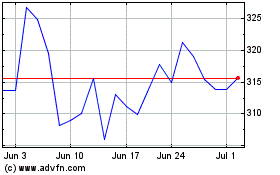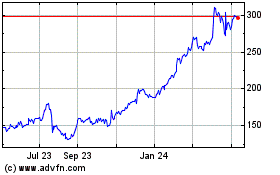Spotify Loss Deepens Despite Subscriber, Podcast Growth
July 29 2020 - 6:29AM
Dow Jones News
By Anne Steele
Spotify Technology SA deepened its loss in the three months
ended June 30, as its recent stock run-up came with
higher-than-expected payroll taxes that offset strong user
growth.
The Stockholm-based music-streaming company said customers'
overall time spent listening to the service recovered to
pre-pandemic levels, as habits began to normalize after an initial
upset brought on by Covid-19.
The global health crisis began to drag on the business in the
first quarter of the year, with declines in daily active users and
overall listening. However, by the end of June all regions had come
back except for Latin America, where cases have sharply risen.
At the end of the second quarter Spotify had 299 million monthly
active users and 138 million paying subscribers, its most lucrative
type of customer, with both coming in at the top of its guidance.
Growth in North America was stronger than the company expected,
more than making up for softness in Latin America and other
emerging markets that saw upticks in subscriber cancellations and
payment failures.
During the quarter, average revenue per user for the
subscription business slipped 9% to EUR4.41 ($5.17). The decline
stemmed mostly from new subscribers coming in via discounted plans
through family and student accounts as well as lower pricing power
in new international markets.
Spotify's revenue from subscriptions climbed 17% to EUR1.76
billion. Ad-supported revenue -- which had been on a double-digit
rise before the pandemic -- slid 21% to EUR131 million. The company
said ad sales slowed amid the pandemic but started to improve in
June, and podcast advertising performed better than anticipated.
Advertising is a relatively small part of Spotify's business --
accounting for 10% or less of overall revenue -- but has been a
growth area over the past year, as the company has expanded its
podcast business.
The company said 21% of its monthly active users now listen to
podcasts, up from 19% in the previous quarter, while overall
consumption of podcasts more than doubled.
In all for the period, Spotify posted a loss of EUR356 million,
or EUR1.91 a share, versus EUR76 million, or 42 European cents a
share, in the year-earlier quarter. A recent spate of deals has run
the company's stock up more than 70% since the end of May, when
comedian Joe Rogan's podcast was announced to be coming exclusively
to Spotify. The deeper loss was owing to the taxes the company
accrues on its employees in Sweden -- more than one-third of its
workforce -- as determined by the stock price at the end of each
quarter.
During the quarter, the company also announced exclusive
podcasting deals with Warner Bros.'s DC superhero brand and Kim
Kardashian. Last week Spotify struck a new licensing agreement with
Vivendi SA's Universal Music Group that signs the largest music
company onto its "two-sided marketplace" for selling marketing and
data back to labels.
Free cash flow -- a measure of the cash a company generates from
operations and a gauge that many investors view as a proxy for
performance -- was EUR27 million, down from EUR50 million a year
earlier.
Revenue rose 13% to EUR1.89 billion, in line with guidance.
For the current quarter, the company forecast monthly active
users to grow to between 312 million and 317 million, and for
premium subscribers to rise to between 140 million and 144 million.
Revenue is expected to come in between EUR1.85 billion and EUR2.05
billion.
News Corp's Dow Jones & Co., publisher of The Wall Street
Journal, has a content partnership with Spotify's Gimlet Media
unit.
Write to Anne Steele at Anne.Steele@wsj.com
(END) Dow Jones Newswires
July 29, 2020 06:14 ET (10:14 GMT)
Copyright (c) 2020 Dow Jones & Company, Inc.
Spotify Technology (NYSE:SPOT)
Historical Stock Chart
From Mar 2024 to Apr 2024

Spotify Technology (NYSE:SPOT)
Historical Stock Chart
From Apr 2023 to Apr 2024
